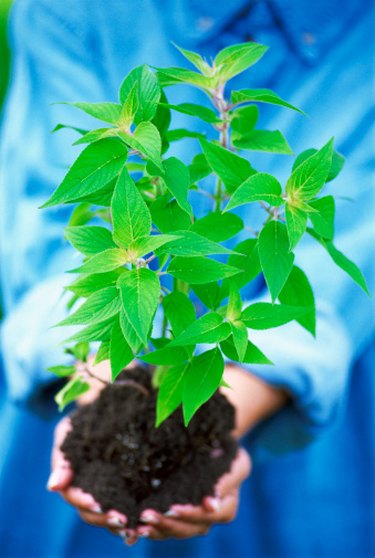
Loamy soil is a medium-textured soil that contains several different soil particles. It is preferred by gardeners as it provides an ideal environment for many types of plants to grow in. It tends to be soft and crumbly when dry and sticky and moldable when moist. Loamy soils have a low organic content and are often found in valleys and areas of land near rivers, lakes or streams.
About Soil Types
Soil is composed of various sizes of tiny particles and organic matter that are categorized as sand, silt or clay. Sand is the largest of soil particles, retaining little water but providing good aeration. Clay, the smallest type of soil particle, tends to compress easily, which makes for poor drainage and allows little to no air to penetrate the soil. Silt particles are medium size, with water absorption and aeration properties between those of sand and clay.
Loamy Soil
Loamy soil consists of almost equal amounts of sand, silt and clay--ideal for gardening. This mixture of particles creates a soil that absorbs and retains moisture but which also drains well, allowing air to reach the roots of the plants. Loamy soil is loose; when squeezed, it can be formed into a ball that crumbles easily.
Types of Loamy Soil
Loamy soils are divided into categories, depending on its content of sand, silt and clay particles. Loamy sands, for example, consist of 70 to 90 percent sand, 30 percent or less silt and 0 to 15 percent clay. This type of loamy soil is loose like sand. Clay loam consists of a more even distribution of the three types of soil yet feels like it has more clay. It is sticky when wet and can be formed easily into a ball. Finally, silt loam has a small amount of sand and clay but is mostly composed of silt particles. The texture is lumpy, but the lumps are easily crushed into a soft powder.
Growing in Loamy Soil
The benefits of growing plants in loamy soils depend on the predominant particle type within it. Loamy soils with an even distribution of clay, sand and silt particles are easy to work with and provide an ideal environment for most plants. Clay loams are heavy and drain slowly. In dry conditions, the surface hardens and cracks. Sandy loams aerate very well but dry out fast and lose nutrients. Silty loams tend to settle into a dense, airless soil that is not beneficial for growing.